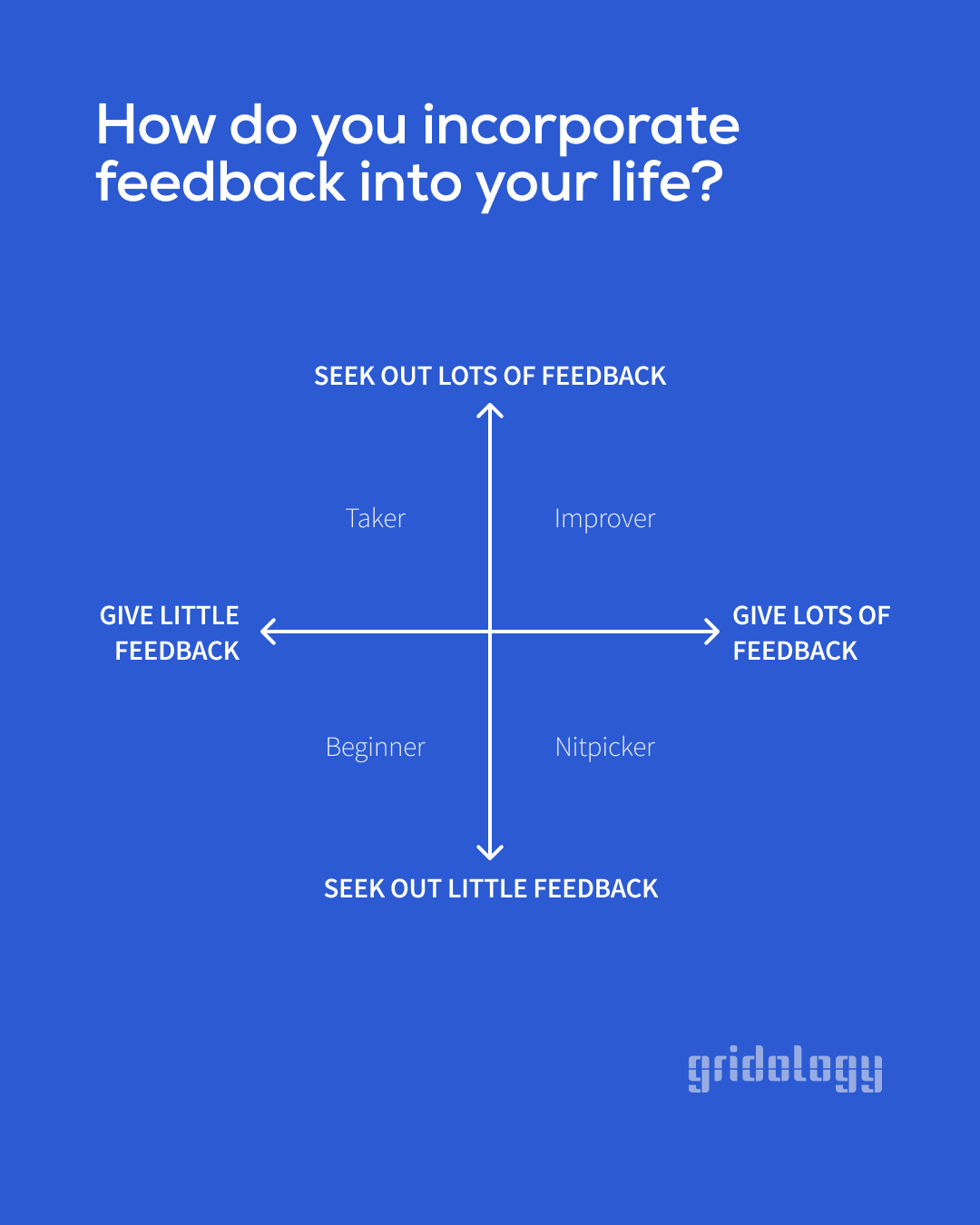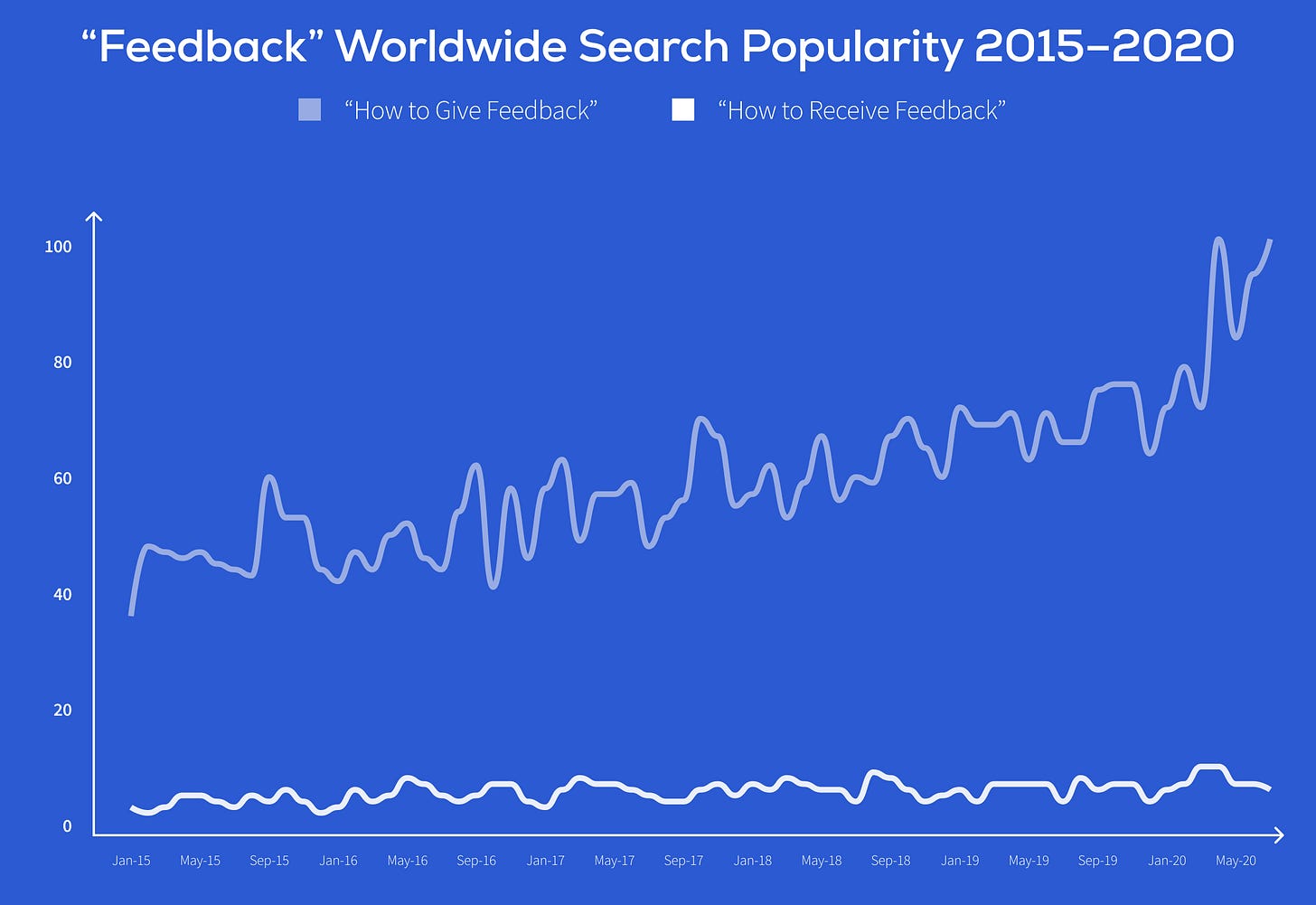Hello to the ~35 new subscribers since last week! As a reminder, Gridology is a newsletter meant to help provide analytical and logical rigor to your decision-making process. Each week, I answer personal and professional questions using a 2x2 grid.
We hit a milestone this week: 200 subscribers! Special shout out to all who have been reading since week one. Over the weeks, Gridology has become a serious time commitment. In turn, I’d love it if you could share it with two people who you think would love this email in their inbox on Sunday mornings. I hope to continue building this community of logical thinkers so more people can benefit from breaking down complex questions into their necessary components. It’s a necessary skill that everyone should have in their toolkit.
With all that said, let’s jump in:

The best way to improve performance—in life or business—is through feedback. Today, I am a firm believer in this. However, it took time to get here.
Growing up, receiving constructive feedback was a tough thing for young Ross to swallow. I used to have the “I know best” attitude, where I could do no wrong. Feedback sent my way was immediately thrown in the trash or understood as an insult. Outwardly, I was judgmental—micromanaging others who were doing things in ways I wouldn’t have. Eventually (thankfully), I began to see feedback not as personal attacks, but (sorry for being cliché here) as a gift. It took time and training, but it was well worth it.
Feedback, by its simplest definition, is a review designed to improve performance.
Take a moment. Think about that! Someone is going out of their way—spending their time and risking their relationship with you to make you better. Wild.
While collecting and acting on feedback is used to improve nearly everything in life—products, food, movies, television shows, clothing—what I want to talk about is personal and professional feedback.
Let’s talk about what it means to both give and get feedback. Generally speaking, humans like to judge others quicker than we judge ourselves. Here’s some Google Trends data to prove it:

Data from Google Trends (January 2015—July 2020)
To me, we should strive to live in a feedback-rich world. That requires giving feedback as often as we receive it. Clearly, the data shows otherwise. Lots of us are trying to master how to give feedback while just a few of us are trying to learn how to better receive it. Both are essential, but I think learning how to receive feedback well is more important.
After all, that’s how we improve.
On the x-axis, we have how much feedback you give. This can be in an organized environment (say a mid-year review) or an ad-hoc format. What’s important here is to get a general sense of how often you’re providing constructive feedback.
On the y-axis, we have how much feedback you seek out. Again, this can be in an organized or ad-hoc fashion. The important thing to take note of is how often you’re asking others for these opportunities to learn.
Understanding the Grid
With this grid, the objective is to try to get yourself in the top right quadrant, to become an Improver. When you’re an Improver, you’re fully engaged in the feedback ecosystem. You give and receive feedback often. We all should want to create a world in which this is normal, encouraged, and desired.
Improver
You give lots of feedback to others, and you also seek out lots for yourself. Improvers are always looking to make themselves and others better. Since Improvers have a growth mindset, they don’t interpret feedback directed at them as a personal attack. Improvers welcome feedback because they recognize it comes from a good place. Given it is understood that feedback is a way of showing you care, Improvers are quick to share some with others. To me, Improvers are comfortable in their skin. They’re aware they have a lot to offer the world, yet recognize they don’t have all the answers. If you aren’t yet an Improver, strive to be. The easiest way to get there is to find other Improvers and befriend them. Observe them. How do they solicit feedback? I find Improvers are always asking others questions after projects or difficult circumstances. Post-mortem analyses are common for Improvers because they seek to get better daily by calibrating around feedback.
Nitpicker
You give lots of feedback to others, but you seek out little for yourself. Nitpickers find faults in many things that others do, but fail to recognize they too have the power to be wrong. There is a “center of the universe” aura to these types of people. They tend to be arrogant and don’t recognize that they don’t have all the answers all the time. Given this mindset, they don’t look to others for help or guidance. Since Nitpickers rarely ask for feedback, it feels like they are being attacked when they unsolicitedly receive some. That’s because they’re shocked that anyone could not understand that their way of doing something isn’t, in fact, the better way. Nitpickers could benefit from finding the right Improver to teach them how to better understand the value of feedback. Given feedback is synonymous with being wrong to Nitpickers, it requires retraining to associate the feedback with improvement rather than failure.
Taker
You give little feedback to others, but you seek out lots for yourself. Takers often are hungry to improve because they recognize the power of feedback to accelerate their growth. Sometimes Takers can be timid—they lack the self-confidence to believe they’re doing things the right way. Thus, they’re always asking for feedback to verify if they’ve taken the right course of action. Feedback here acts as a litmus test. When they do provide feedback to others, it feels overwhelming and scary. Takers may not know the right words to say and fear that their feedback may unintentionally come off as an attack. Takers could benefit from learning how to deliver feedback in a productive and caring way. It requires a shift in mindset and some courage to fail a few times before getting it right.
Beginner
You give little feedback to others, and you also seek out little for yourself. Beginners tend to be dominated by fear, apathy, and/or confusion. This primarily is due to inexperience with feedback in life or business. Feedback requires finesse. If you’re new to feedback—as Beginners tend to be—you don’t understand the value it provides nor the proper way to deliver it. This creates confusion. Feedback is something that feels foreign and scary, and thus Beginners shy away from it. Beginners do not want to give feedback as they question their authority to do so. They don’t seek it out as they don’t understand that it’s required to develop their interpersonal and professional skillset. With a bit of coaching, Beginners can become Improvers in no time.
Grid Shortcomings
There are two shortcomings with this grid:
Feedback is only as good as it’s delivery. You can give as much feedback as you want. However, if it’s not delivered constructively and honestly, then you run the risk of having your message being outright rejected. Thus, the x-axis doesn’t indicate if the feedback given is well received.
Feedback is only valuable if you do something with it. You can seek out all the feedback you want, but if you choose to never take action on any of the points, then what good is it? Thus, the y-axis doesn’t indicate if the feedback you received is internalized and acted on.
Feedback is critical for development. It’s been at the top of my mind this week. Life is a game with rules that are changing constantly. Thus, we all need to iterate as we go—getting a little bit better day by day.
Life’s only as confusing as you let it be,
Ross
P.S. There’s a new addition to the Gridology team. He’s joining the staff as a community engagement manager. There’s a lot of training to do before he’s fully ramped up. Say hello to Murray, everyone.

If you enjoyed today’s Gridology post, please consider forwarding it to your friends, family, or colleagues. As always, please reply to this note if you have any feedback or ideas.



